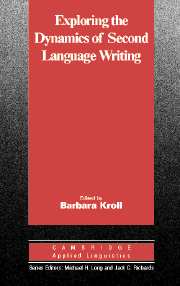Book contents
- Frontmatter
- Contents
- List of contributors
- Acknowledgments
- List of abbreviations used
- Series editors' preface
- Introduction: Teaching the next generation of second language writers
- I EXPLORING THE FIELD OF SECOND LANGUAGE WRITING
- II EXPLORING THE VOICES OF KEY STAKEHOLDERS:TEACHERS AND STUDENTS
- III EXPLORING WRITERS' FINISHED TEXTS
- IV EXPLORING CONTEXTUALITIES OF TEXTS
- Chapter 8 Genre and ESL/EFL composition instruction
- Chapter 9 Changing currents in contrastive rhetoric: Implications for teaching and research
- Chapter 10 Reading and writing relations: Second language perspectives on research and practice
- Chapter 11 Literature in the teaching of second language composition
- V EXPLORING TECHNOLOGY
- EPILOGUE: EXPLORING OURSELVES
- Index
Chapter 11 - Literature in the teaching of second language composition
Published online by Cambridge University Press: 05 October 2012
- Frontmatter
- Contents
- List of contributors
- Acknowledgments
- List of abbreviations used
- Series editors' preface
- Introduction: Teaching the next generation of second language writers
- I EXPLORING THE FIELD OF SECOND LANGUAGE WRITING
- II EXPLORING THE VOICES OF KEY STAKEHOLDERS:TEACHERS AND STUDENTS
- III EXPLORING WRITERS' FINISHED TEXTS
- IV EXPLORING CONTEXTUALITIES OF TEXTS
- Chapter 8 Genre and ESL/EFL composition instruction
- Chapter 9 Changing currents in contrastive rhetoric: Implications for teaching and research
- Chapter 10 Reading and writing relations: Second language perspectives on research and practice
- Chapter 11 Literature in the teaching of second language composition
- V EXPLORING TECHNOLOGY
- EPILOGUE: EXPLORING OURSELVES
- Index
Summary
Writing instructors constantly face curricular decisions about which types of approaches, methods, and materials should be used to teach writing most effectively. Instructors have to explore many curricular possibilities and make conscious decisions based on their own prior training, the educational setting in which they teach, their goals for the classes, and the needs of their students. One such decision concerns whether, and how, to use literature in writing classes. These particular questions reflect an ongoing controversy in professional conversations in both first language (L1) and second language (L2) settings. This chapter summarizes arguments for and against the use of literature in writing classes, outlines the history of the controversy in both fields, and explores questions that arise when a choice is made to use literature, including the following concerns: Which genres of literature are appropriate in the L2 writing class? What is the place of multicultural and international literature in the L2 writing class? How can literature best be used to enhance writing instruction? Exploring these types of questions should prove helpful to teachers in training as well as to experienced teachers, all of whom want to make informed and productive decisions about the curricula and goals of their writing classes.
While the focus in this chapter is on adults, particularly college students, much of what is said also applies to younger students, especially high school students.
- Type
- Chapter
- Information
- Exploring the Dynamics of Second Language Writing , pp. 263 - 284Publisher: Cambridge University PressPrint publication year: 2003
- 8
- Cited by



